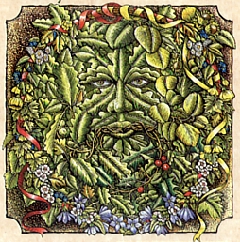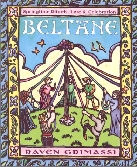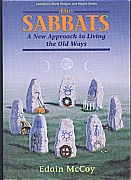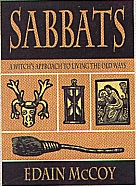






 Beltane (most commonly pronounced "BELL-tayn", but also can be "BEEL-teen", "BEEL-tawn-uh", or "B'YAL-tinn") is one of the Greater Wiccan Sabbats and is usually
celebrated on May 1st, but can be on the night of April 30th, depending on your tradition or - if
you are solitary - simply your personal choice. In the Celtic tradition it is celebrated on May 1st
or the first Full Moon in Taurus. The Scottish tradition of PectiWita celebrate their Sabbat on May 15th.(Images to the left and below are by Anthony Meadows and from Llewellyn's 1998 and 1999 Witches' Calendars. Click on either image to go directly to Llewellyn's Web Site.)
Beltane (most commonly pronounced "BELL-tayn", but also can be "BEEL-teen", "BEEL-tawn-uh", or "B'YAL-tinn") is one of the Greater Wiccan Sabbats and is usually
celebrated on May 1st, but can be on the night of April 30th, depending on your tradition or - if
you are solitary - simply your personal choice. In the Celtic tradition it is celebrated on May 1st
or the first Full Moon in Taurus. The Scottish tradition of PectiWita celebrate their Sabbat on May 15th.(Images to the left and below are by Anthony Meadows and from Llewellyn's 1998 and 1999 Witches' Calendars. Click on either image to go directly to Llewellyn's Web Site.)
Other names used for this Sabbat are Bealtaine (Irish Wittan), Whitsun or Old Bhealltainn (Scottish PectiWita), Bealtinne (Caledonii or the Druids), Samhradh and La Baal Tinne (Faery Wicca), Roodmas, Rudemas (Mexican Craft), Walburga (Teutonic), Walpurgisnacht (German), Walpurgis Eve, Celtic Summer, Giamonios, Tana's Day - La Giornata di Tana (Aridian Strega), Floralia, The Great Rite, May Day, and May Eve. It is also known as Cetshamain in Ireland, and is one of the few specifically Irish festivals. (Images to the left and below are by Anthony Meadows and from Llewellyn's 1998 and 1999 Witches' Calendars. Click on either image to go directly to Llewellyn's Web Site.)
 This Sabbat is primarily a fertility festival, with Nature enchantments and offerings to wildlings
and Elementals. The return of full-blown fertility is now very evident. The powers of elves and
fairies are growing and will reach their height at Summer Solstice. Celebrants sometimes jump
over broomsticks or dance around May Poles, both as symbols of fertility. Bonfire leaping and
horn blowing are other forms of traditional celebration. Weaving and plaiting are traditional arts
at this time of year, for the joining together of two substances to form a third is in keeping with
the spirit of Beltane. This Sabbat represents the Union of the God and Goddess, the Sacred
Marriage, all new life, and fertility for all living things.
This Sabbat is primarily a fertility festival, with Nature enchantments and offerings to wildlings
and Elementals. The return of full-blown fertility is now very evident. The powers of elves and
fairies are growing and will reach their height at Summer Solstice. Celebrants sometimes jump
over broomsticks or dance around May Poles, both as symbols of fertility. Bonfire leaping and
horn blowing are other forms of traditional celebration. Weaving and plaiting are traditional arts
at this time of year, for the joining together of two substances to form a third is in keeping with
the spirit of Beltane. This Sabbat represents the Union of the God and Goddess, the Sacred
Marriage, all new life, and fertility for all living things.
Most Wiccans consider this Sabbat to be the start of the Light Half of the Year - the Summer - as opposed to the Dark Half of the Year - Winter - which begins on Samhain. Most Wiccans view this as the half of the year which is ruled by the Goddess, while the dark half is ruled by the God. As I stated above - this is a fertility Sabbat - and traditionally is considered to be the time that the God and Goddess are wed. It is also considered to be the time that He impregnates Her as they are "sexually connected" on this day. This is represented symbolically by the wrapping of the May Pole. In the olden days, the May Pole was made from a communal pine tree which had been decorated at Yule, with most of its branches removed at this time. A few of the uppermost branches could remain if desired. Traditionally, the ribbons attached around the top of the May Pole are red and white... this is to represent either one of these: the red as the Sun God and the white as the Virgin Goddess, or the white for the Maiden and the red for the Mother. The participants dance around the May Pole carrying the ribbons - the males holding the red and the females holding the white. As they dance, they weave and intertwine the ribbons to form a symbolic birth canal wrapped around the phallic pole, representing the union of the Goddess and God. Many Wiccans choose this time to perform their own Handfastings or Weddings. Another great choice would be the next Sabbat at the Summer Solstice.
Symbolically, many Pagans choose to represent Beltane with fresh flowers all around and the cauldron which is filled with flowers. All of the following flowers are symbolic of Beltane: roses, bluebells, marigolds, daisies, primroses and lilac. Mirrors are also appropriate. Altar decorations may also include a small May pole and/or a phallic-shaped candle (to represent fertility), and a daisy chain. Plaiting and weaving straw, creating things with wicker, making baskets and fabrics are traditional arts for this turn in the Wheel of the Year. Other symbols used to represent Beltane are the May Pole (the traditional full-size one is about 10 feet tall), May baskets, crossroads, eggs, butterchurns, and chalices.
Traditional activities include the already mentioned wrapping of the May Pole, the Great Rite, jumping the balefire, blowing horns, and gathering flowers. Solitary Practitioners might consider the weaving together of ribbons as an alternative to creating and dancing around the May Pole. It is considered taboo to give away fire or food on this day.
Appropriate Deities for Beltane include all Virgin-Mother Goddesses, all Young Father Gods, all Gods and Goddesses of the Hunt, of Love, and of Fertility. Some Beltane Goddesses to mention by name here include Aphrodite, Arianrhod, Artemis, Astarte, Venus, Diana, Ariel, Var, Skadi, Shiela-na-gig, Cybele, Xochiquetzal, Freya, and Rhiannon. Beltane Gods include Apollo, Bacchus, Bel/Belanos, Cernunnos, Pan, Herne, Faunus, Cupid/Eros, Odin, Orion, Frey, Robin Goodfellow, Puck, and The Great Horned God.
One key action to keep in mind during this time in the Wheel of the Year is to take action on the activities and projects you had planned and started on Ostara. Spellwork to consider include those for fertility, love, spiritual communion/closeness with deity, safety, prosperity, and conservation. This being a time of great magick, is a good time for divinations of all types, and for establishing a woodland or garden shrine. The household guardians should be honored at this time.
The most common colors associated with Beltane are white and dark green, but also appropriate are all the colors of the rainbow spectrum itself. Stones to use during the Beltane celebration include sapphires, bloodstones, emeralds, orange carnelians, and rose quartz.. Animals associated with Beltane are goats, rabbits, and honey bees. Mythical beasts associated with Beltane include faeries, pegesus, satyrs, and giants.
Plants and herbs associated with Beltane are primrose, yellow cowslip, hawthorn, roses, birch trees, rosemary, and lilac. Also included are almond, angelica, ash trees, bluebells, cinquefoil, daisies, frankincense, ivy, marigolds, satyrion root, and woodruff. For Beltane incense, you could make a blend from any of the following scents or simply choose one... frankincense, lilac, passion flower, rose, or vanilla.
Foods in tune with this day (linking your meals with the seasons is a fine way of attuning with Nature) traditionally come from the dairy, and dishes such as marigold custard (see Scott Cunningham's recipe below) and vanilla ice cream are fine. Sweets of all kinds, honey, and oats are fine fare for Beltane. Additional foods to include are all red fruits such cherries and strawberries, green herbal salads, and red or pink wine punch. Oatmeal or barley cakes, sometimes known as "Beltane Cakes", are also appropriate.
May the Lord and Lady bless you all with abundance and success!

Next I will list several recipes appropriate for the Beltane turn in the Wheel of the Year. I have gathered these from various places, noted on each...

Beltane Bread
Preheat oven to 375 degrees, and combine:
4 cups sifted flourWhen dough is worked to medium soft, shape into flattened balls and place on ungreased cookie sheet. Bake until golden brown, about 20 minutes. Cool, ice with white Solar Cross. You could try this as a single loaf. I also like to make an almond biscuit with biscuit mix, almond extract, sugar, cinnamon, and eggs, but in smaller proportions. (A lot of my cooking is unmeasured, which doesn't help for making recipes.)
(The above recipe for "Beltane Bread" is directly quoted from Ann Moura (Aoumiel)'s book "Green Witchcraft: Folk Magic, Fairy Lore & Herb Craft", page 218, Llewellyn Publications, 1996.)

Short-Cut Meade (Pan-Celtic)
This rich ale known as meade is a very old Celtic creation which was used for sacred rituals. It was thought to be a gift of the deities and was used to honor them, especially at Beltane. Many recipes exist, and most are jealously guarded. This short-cut method ignores the lengthy fermentation process.
1/2 gallon water
1-1/2 cups raw honey
1/4 cup lemon juice
1/8 teaspoon nutmeg
1/8 teaspoon allspice, rounded
1/2 cup Everclear (R)
Slowly heat all ingredients together --- except the alcohol --- in a large stock pot. As the honey melts, an oily crust will form on the top of the meade. You can leave it there, for some feel this adds to the full-bodied texture of the meade, while others will tell you to skim it off. Do not allow the meade to come to a roiling boil. When it is well blended, remove from the heat, stirring occasionally until it settles. When it has cooled, add the Everclear (R) and serve.
(The above recipe for "Short-Cut Meade (Pan-Celtic)" is directly quoted from Edain McCoy's book "Celtic Myth & Magick: Harnessing the Power of the Gods and Goddesses", page 390, Llewellyn Publications, 1995)

Beltaine Cream Pie
Prepare and pre-bake a pie shell and have it ready in the pie dish. The pie filling will be warmed but not baked.
1 cup whole milkMelt the butter in a wide cooking pan. (The mixture heats more evenly in this than in a taller more narrow pan Traditionalists will use a heavy cast iron pan.)
In a separate bowl slowly add the milk to the cornstarch making sure it is fully dissolved and absorbed before adding more milk. When the cornstarch is fully blended add this and all the other ingredients, except the vanilla, to the cooking pan.
Stir constantly over medium heat until the mixture becomes thick like a pudding. Remove from heat and stir in the vanilla.
Pour the mixture into the waiting pie shell and sprinkle with nutmeg. the pie may be eaten while it is still warm as long as it has cooled just enough to set. Or the pie may be chilled and eaten later.
(The above recipe for "Beltaine Cream Pie" is directly quoted from Edain McCoy's book "Witta: An Irish Pagan Tradition", page 187, Llewellyn Publications, 1993/1994)

Beltane Marigold Custard
2 cups milk
1 cup unsprayed marigold petals
1/4 tsp. salt
3 Tbsp. sugar
1 to 2-inch piece vanilla bean
3 egg yolks, slightly beaten
1/8 tsp. allspice
1/8 tsp. nutmeg
1/2 tsp. rose water
whipped cream
Using a clean mortar and pestle reserved for cooking purposes, pound marigold petals. Or, crush with a spoon. Mix the salt, sugar and spices together. Scald milk with the marigolds and the vanilla bean. Remove the vanilla bean and add the slightly beaten yolks and dry ingredients. Cook on low heat. When the mixture coats the spoon, add rose water and cool.
Top with whipped cream, garnish with fresh marigold petals.
{The above recipe for "Beltane Marigold Custard" is quoted directly from Scott Cunningham's book "Wicca: A Guide For The Solitary Practitioner", page 153, Llewellyn Publications, 1988/1990.)

Wiccan Handfasting Cake
1 cup butter
1 cup sugar
1/2 cup honey
5 eggs
2 cups flour
2 tablespoons grated lemon rind
2-1/2 teaspoons lemon juice
1 teaspoon rose water
pinch of basil
6 fresh rose geranium leaves
In a large mixing bowl, cream the butter and sugar until fluffy and light. Add the honey and mix well. Add the eggs, one at a time, beating well after each addition. Gradually add the flour and blend thoroughly with a large wooden spoon after each addition. Stir in the lemon rind, lemon juice, rose water and a pinch of basil --- the herb of love. Line the bottom of a greased nine-by-five-by-three-inch loaf pan with the rose geranium leaves and then pour in the batter. Bake the cake in a preheated 350 degree oven for one hour and fifteen minutes. Remove from oven when done and let stand on a rack for twenty minutes before unmolding. Spread icing or sprinkle sugar on top of the Handfasting Cake just before serving.
{The above recipe for "Wiccan Handfasting Cake" is quoted directly from Gerina Dunwich's book "Wicca Craft: The Modern Witch's Book of Herbs, Magick, and Dreams", page 147, A Citadel Press Book, Carol Publishing Group, 1991/1995)

45 drops frankincense oil
1 cup oak moss
1 cup dried bluebells
1 cup dried lilac
1 cup dried marigold
1 cup dried meadowsweet
1 cup dried rosebuds and petals
1 cup dried yellow cowslips
Mix the frankincense oil with the oak moss and then add the remaining ingredients. Stir the potpourri well and store in a tightly covered ceramic or glass container.
(The above recipe for "Beltane Ritual Potpourri" is quoted directly from Gerina Dunwich's book "The Wicca Spellbook: A Witch's Collection of Wiccan Spells, Potions and Recipes", page 162, A Citadel Press Book, Carol Publishing Group, 1994/1995)

Beltane Incense
Burn during Wiccan rituals on Beltane (April 30th) or on May Day for fortune and favors and to attune with the changing of the seasons.
(The above recipe for "Beltane Incense" is quoted directly from Scott Cunningham's book "The Complete Book of Incenses, Oils & Brews", page 60, Llewellyn Publications, 1989/1992.)


Beltane
Each Beltane, to dance around the maypole---the symbol of fertility in man, the symbol of life on Earth---is to celebrate aliveness and awareness. The May King and May Queen are sent into the fields to fertilize the land. The time is ripe for creativity, for imagination. In symmetry with Hallowmas, the veil between the worlds is thin; thus allowing the playful, fantastical aspects of the spirit world access in order to celebrate living and laughing with those on the physical plane of the Earth.

A May Day Carol
Awake, awake, my pretty prithy maid,
Come out of your drowsy dream,
And step into your dairy hold,
And fetch me a bowl of cream
If not a bowl of cream, my dear,
A cup of meade to cheer,
For the Lord and Lady know we shall meet again,
To go Maying another year.
A branch of May I brought you here,
While at your keep I stand,
'Tis but a sprout all budded out,
By the power of our Lady's hand.
My song is done and I must be gone,
No longer may I stay,
Gods bless you all, the great and small,
And send you a joyous May.


Lord of the Dance
When she danced on the water and the wind was her horn
the Lady laughed and everything was born
And when she lit the sun and the light gave him birth
the Lord of the Dance first appeared on the Earth.
Chorus:
So, dance, dance, wherever you may be
I am the Lord of the Dance, cried he
And I'll live in you if you live in me,
And I'll lead you all in the dance, cried he
I came with the dawning when the world was begun
I danced with the moon, and the stars, and the sun
When I saw the light that was coming from the Earth
I joined in the rhythm and she gave me birth
(Chorus)
I grow in the kernel and I bring forth the grain
I flow with the wind as I dance in the rain
When it's time for harvest I will never feel the pain
for in spring I am Lord of the dance once again
(Chorus)
I dance at the feast and stories I do tell
I dance and I sing that everyone be well
and when the dance is over do not think that I am gone
for I live in the music so I dance all along
(Chorus)
I dance in the circle when the flames leaped up high
I dance in the fire and I never, ever die
Feel me in the drumming as I call to you
when you hear my voice you'll know just what to do
(Chorus - three times)

From Beltaine to Midsummer, the faery kingdom celebrates the newborn spring. Throughout the centuries, Europeans made note of which vernal foliage was attractive to the wee folk and, by contrast, which plants would offer protection. Those plants marked with an asterisk (*) are poisonous and should be cultivated only with great caution, and should never be grown wherever children or pets are present.
Bluebell --- If bluebells ring in your garden, an evil faery is near.
Carnation --- The red ones draw faeries who enjoy healing animals.
Clover --- Wildly attractive to faery life.
Cowslip --- The best choice for attracting faeries to your yard.
Dandelion --- Believed to be used by faeries to make beverages.
Dill --- The fresh plant has a scent faeries dislike.
Foxglove* --- A favorite of earth elementals.
Hawthorne --- Sacred to faeries, as well as to May Queen.
Heliotrope* --- Enjoyed by fire elementals.
Gorse --- Repels virtually all faery life.
Hollyhock* --- A faery favorite, particularly the pink variety.
Lilac --- The gentle scent draws faery life.
Lobelia* --- Will help attract winged faeries.
Mistletoe* --- Can also attract unpleasant tree faeries.
Morning Glory* --- Repels unwanted night faeries
Mushrooms* --- Often used by faeries to mark the boundaries
of their sacred circles or portals to their world.
Pansy --- Known to attract parades of trooping faeries.
Primrose --- Believed to give faeries their power of invisibility.
Rosemary --- The fresh plant protects from baneful faeries.
Sassafras --- Enjoyed by air elementals.
Shamrock --- A form of clover Celtic faeries adore.
(The above article for "Flowers, Herbs, and the Faeries of May" is written by Edain McCoy and directly quoted from "Llewellyn's 1995 Magical Almanac", pages 88-92, Llewellyn Publications, 1994.)

Come lasses and lads, get leave of your dads,
And away to the Maypole hie,
For every he has got a she,
And the fiddler's standing by.
For Willie shall dance with Jane,
And Johnny has got his Joan.
To trip it, trip it, trip it, trip it, trip it up and down.

For LOTS more GREAT information on the Beltane Sabbat and all the others, I highly recommend the following books. (Click on the book images to go directly to that particular book at Amazon.com).

"Beltane: Springtime Rituals, Lore and Celebration" by Raven Grimassi
The "Sabbats" book below has a NEW title and cover, but I have placed BOTH the old and new covers here to try and help alleviate any confusion. Both links go to the same Web Page.

OLD Cover & Title: "The Sabbats: A New Approach to Living the Old Ways" by Edain McCoy

NEW Cover & Title: "Sabbats: A Witch's Approach to Living the Old Ways" by Edain McCoy


I have been overwhelmed with e-mail lately and a lot of it is of a nature that I am not able to handle at this point in my current life. Many people have written asking me to become their Wicca Teacher or Mentor and I am unable to comply right now. I am Disabled from a serious back injury and just sitting here writing/answering e-mail causes a large increase in pain, so I usually simply cannot do it. Otherwise, my plate is about as full as it can get. I'm sorry, but don't write asking me to do this for you, but please continue to and write with your questions, comments, and suggestions...

Please feel free to use the information contained on my Wiccan Web Pages for your own personal use or for the teaching of others... remembering the Wiccan Rede... and harming none... May You Never Thirst, StormWing...

